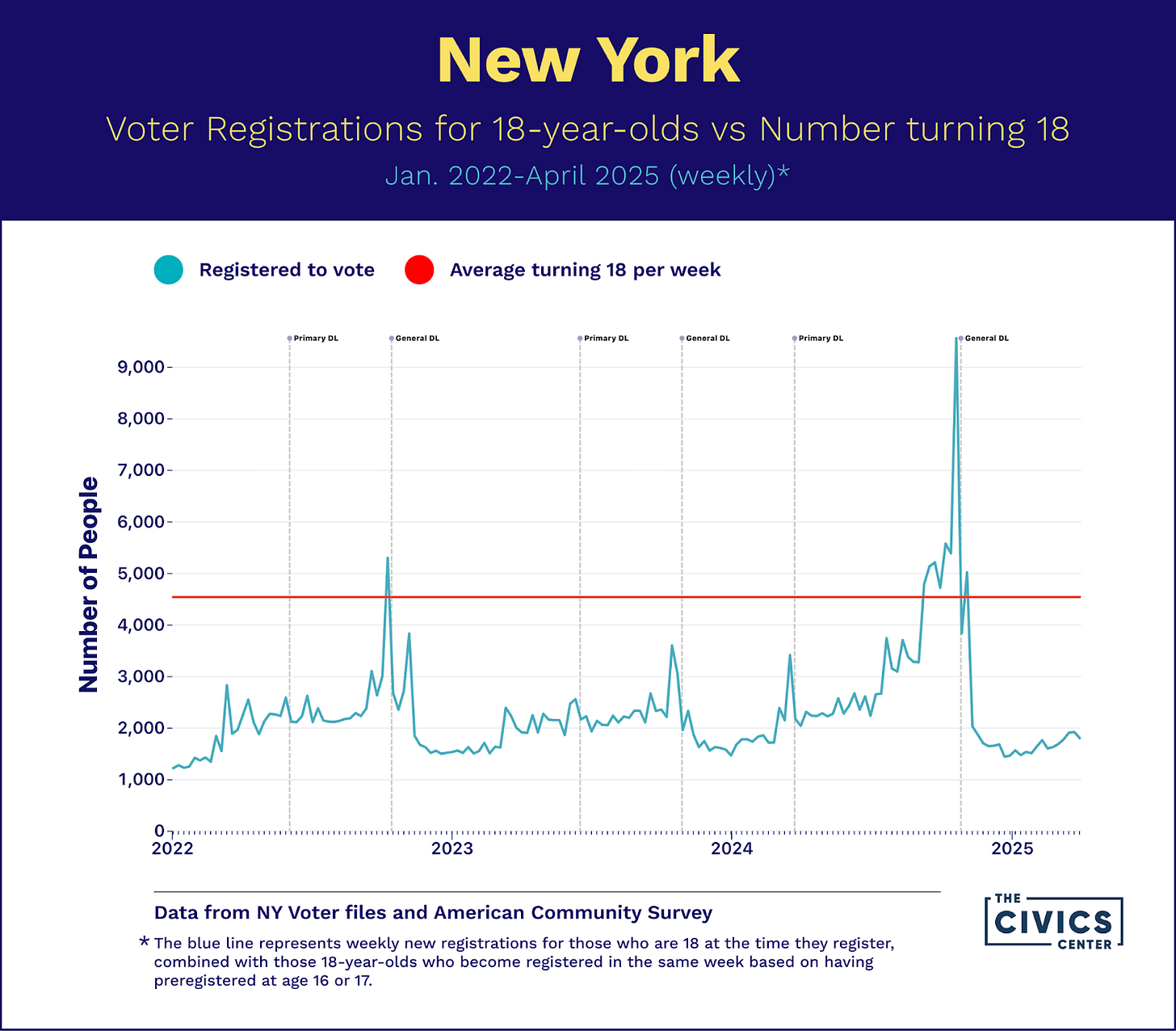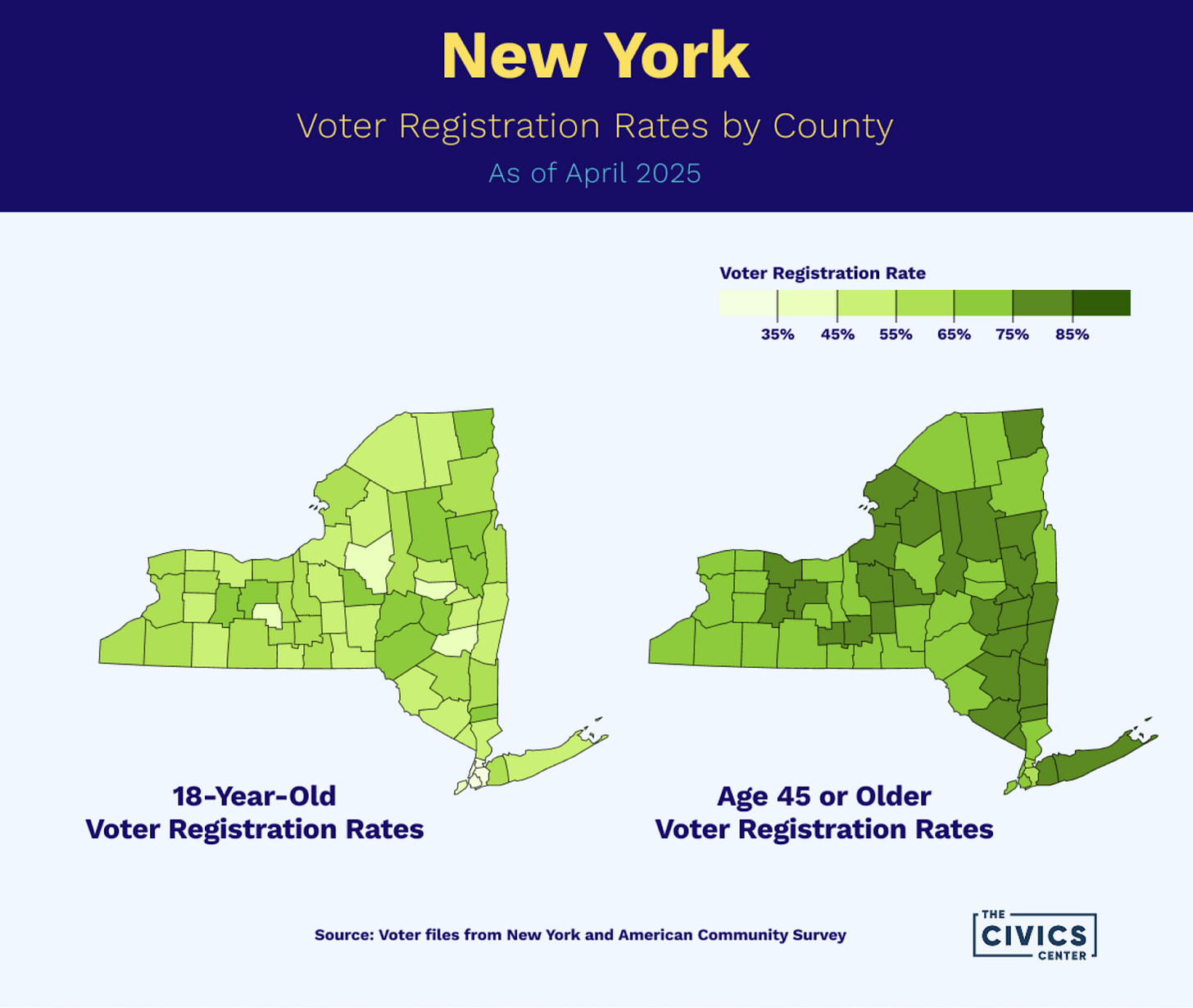These charts will change the way you think about youth turnout
Numbers tell a story, and the charts below tell one of systems that disenfranchise our youngest voters year after year.
When people ask me about low youth voter turnout, my answer is always the same. Let’s start with the numbers. Let’s center the students. Let’s bring in the educators and parents, school districts, community organizations, and policy makers. Let’s remember that registration is a separate process from voting and that our current registration systems miss high school students in the millions, year after year.
It’s a human problem. It’s a systems problem. It’s a data, education, and communications problem. It can’t be explained by negative stereotypes that young people don’t care.
It’s also reversible with the right kinds of investments. Let’s go.
Start with the numbers
Numbers tell a story, and the charts below tell one of systems that disenfranchise our youngest voters year after year.
We know that registration rates for 18-year-olds swing wildly from presidential-election years to odd-numbered years to midterms. This phenomenon is illustrated in this chart, which compares registration rates for 18-year-olds at presidential and midterm elections to rates for those ages 45 and above in the same elections.
If current trends continue and aren’t reversed with serious investment that is sorely needed, millions of 18-year-olds will be disenfranchised in 2026, just as they have been in every midterm election this century.
The above chart tells a national story, and it tracks rates only at midterm and presidential elections. We wanted to know more.
We wanted to know what goes into those wild swings and massively low numbers. We wanted to know when 18-year-olds were registering. To what extent are existing systems working to register the youngest voters, outside of last-minute infusions of cash to drive up registration and turnout in advance of election deadlines? And what is the baseline rate of registration outside of that super-expensive mad dash?
We started with New York because there is a big Mayoral election coming up in New York City. There are also six New York congressional seats on the Cook Political Report’s list of competitive House races for 2026. The other thing about New York is that plenty of people live there who could make a big difference in solving the problem.
The chart below uses the New York voter file and American Community Survey population data to estimate and compare, for every week of the year, going back to 2022, the number of new 18-year-olds in the state (red line) versus the number of new 18-year-old registrants (blue line).
It’s a roller coaster, and one that stays low to the ground much more than it heads skyward.
Here are our takeaways:
In the 3+ years covered by the chart, the only weeks in which the number of new registrants exceeded the number of new 18-year-olds were in the immediate run-up to the registration deadline for the 2022 and 2024 general elections. In every other weekly period, the number of new 18-year-old registrants was far lower than the number of new 18-year-olds. There have only been 9 weeks out of the 170 represented (just 5.3%) in which the number of 18-year-olds registered exceeded the number turning 18.
In most weeks over the past 3+ years, fewer than half of the potential new 18-year-old registrants in fact became registered.
The largest spikes correlate to general elections, with primaries leading to smaller surges. The 2024 election saw only a small uptick for the primaries, likely due to the lack of competitive primaries at the presidential level for either party.
The chart is pretty shocking, right? And once you absorb the dysfunction that it illustrates, it’s easy to see how, leading up to the 2024 election, fewer than 50% of 18-year-olds in the state were registered to vote.
The low registration numbers on a county-by-county basis are further illustrated in the maps below. If our registration systems and campaign programs were working, the map on the left, and especially the NYC region, with its high population, would not be so pale.
The solution? Invest in the students and their communities
While the charts and maps point to a host of problems, they also suggest a roadmap for funders who are interested in systemic, long-lasting change. The answers all involve understanding the reality, committing to the support needed to improve it, and centering the students and their communities.
A central question is who is responsible for ensuring every American is registered to vote the moment they become eligible? How can we blame young people if we, as a society, haven’t welcomed them into democracy with the tools they need to use their voices and make a difference? With dedicated funding, we can build a consistent on-boarding system for up-and-coming voters, welcoming them into our democracy the moment they are eligible.
The baseline
We have to reach students in order to help them make their baseline rate higher. That includes things like outreach, education, and organizing for high school students and their communities to let them know about the importance of using their power in a democracy by registering to vote. It can also include things like improving the state online systems and making more state agencies, including high schools, into voter registration agencies, so that voter registration opportunities will meet high school students where they are.More spikes, longer spikes, higher spikes
The spikes represent campaigns of one kind or another. Resources concentrate in the face of deadlines. People take action because there is urgency and a social context in which to do so. Students are no exception. When it comes to registering and turning out the youngest voters, efforts are likely to have greater impact if outreach starts early and if they focus on achieving more spikes, more often, as well as spikes of greater duration and intensity.
For students, it’s not just the election calendar that counts, but also the school calendar. Imagine, across the country, summer programs to engage and train large numbers of high school students so they can be ready to be leaders in their high schools in the fall and commit to registering their entire class by the time of graduation. Imagine such programs continuing at the same strength in odd years and even years alike so that voter registration doesn’t depend on the election cycle but is simply a rite of passage, part of adulting.











As a former HS teacher (30+ yrs), I see a couple of ways to having a majority of 18 yr olds registered to vote upon graduation. 1st path to voter registration for the majority is to treat it like the milestone that it is. To get there, you have to make it something that they want, something they receive to mark the end of their childhood & beginning of adulthood, (especially) something that creates envy that they can wave in the face of younger siblings/students (yeah, kids are still like that). 2) Civics teachers give up a teaching day & bring in somebody who lectures for 15-20 minutes about how it's our duty to vote, passes out voter registration cards & gives the kids the rest of the period to fill them out & turn them in. Dutiful civics teachers require students to turn in card before leaving the room.
From yr stats, I imagine that #2 is what has been happening - no incentive to carry thru every year, just in the pres election cycle.
If you really want the change, it's going to take longer to work, longer to show improvement, but the rewards are proud, lifelong registered voters who just might decide to be proud lifelong voters.
There's my 2 cents for the day😁
https://www.facebook.com/share/p/1GGEmYKDzU/